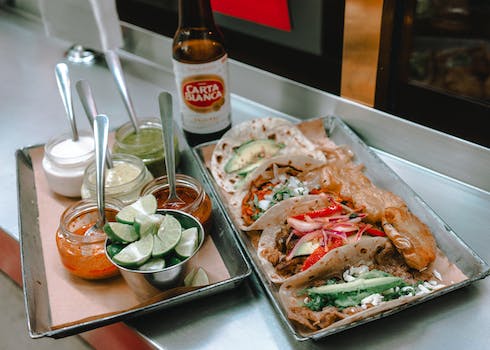

-
Table of Contents
Unveiling the Essence of Nasi Lemak, Beyond Tradition
Introduction
Nasi Lemak is a beloved Malaysian dish that is widely enjoyed for its fragrant coconut rice and flavorful accompaniments. While traditionally served on a banana leaf, this iconic dish has evolved over time, with various versions and interpretations found across Malaysia and even beyond its borders. In this article, we will delve into the world of Nasi Lemak, exploring its origins, regional variations, and the diverse ingredients that make it a truly beloved culinary delight.
The Evolution of Nasi Lemak: From Street Food to Fine Dining
Nasi Lemak, a beloved Malaysian dish, has come a long way from its humble beginnings as a street food staple to being served in fine dining establishments. This evolution is a testament to the dish's versatility and the creativity of chefs who have taken it beyond the traditional banana leaf presentation.
Originally, nasi lemak was a simple breakfast dish enjoyed by Malaysians from all walks of life. It consisted of fragrant coconut rice served with a variety of accompaniments such as sambal, fried anchovies, peanuts, cucumber, and a hard-boiled egg. The dish was traditionally wrapped in a banana leaf, which added a unique aroma and flavor to the rice.
Over time, nasi lemak gained popularity and became a staple in Malaysian street food culture. Hawkers and food stalls would set up shop early in the morning, serving this delicious dish to hungry customers. The affordability and convenience of nasi lemak made it a favorite among locals, who would often grab a packet to enjoy on the go.
However, as Malaysian cuisine gained recognition on the global stage, chefs began to experiment with traditional dishes, including nasi lemak. They started incorporating modern cooking techniques and premium ingredients to elevate the dish to new heights. This marked the beginning of nasi lemak's journey from street food to fine dining.
In upscale restaurants, nasi lemak is now presented in a more refined manner. Chefs have moved away from the traditional banana leaf wrapping and instead opt for elegant plating techniques. The coconut rice is often molded into neat shapes and served alongside beautifully arranged accompaniments. This presentation not only enhances the visual appeal of the dish but also allows for a more controlled balance of flavors.
Moreover, chefs have started to introduce innovative twists to the classic nasi lemak recipe. They experiment with different types of rice, such as black rice or quinoa, to add a healthier and more diverse element to the dish. Additionally, they may incorporate unique ingredients like lobster, foie gras, or truffle to create a luxurious version of nasi lemak that caters to the discerning palates of fine dining patrons.
Despite these modern interpretations, the essence of nasi lemak remains intact. The fragrant coconut rice, spicy sambal, and crunchy accompaniments continue to be the stars of the dish. Chefs understand the importance of preserving these flavors while adding their own creative flair.
The evolution of nasi lemak from street food to fine dining is a testament to the versatility and adaptability of Malaysian cuisine. It showcases the ability of chefs to take a beloved traditional dish and transform it into something extraordinary. Whether enjoyed on a banana leaf or served on a fine china plate, nasi lemak continues to captivate diners with its rich flavors and cultural significance.
In conclusion, the journey of nasi lemak from its humble beginnings as a street food staple to being served in fine dining establishments is a testament to the dish's versatility and the creativity of chefs. The evolution of nasi lemak showcases the ability of Malaysian cuisine to adapt and innovate while preserving its traditional flavors. Whether enjoyed on a banana leaf or presented in an upscale restaurant, nasi lemak continues to be a beloved dish that represents the rich culinary heritage of Malaysia.
Unconventional Ingredients in Nasi Lemak: Exploring New Flavors

Nasi Lemak, a traditional Malaysian dish, is a beloved staple that has captured the hearts and taste buds of people all over the world. This fragrant rice dish, typically served on a banana leaf, is known for its rich and aromatic flavors. However, in recent years, chefs and food enthusiasts have been experimenting with unconventional ingredients to create new and exciting variations of this classic dish.
One of the most intriguing aspects of nasi lemak is its versatility. While the traditional version includes ingredients such as coconut rice, sambal (a spicy chili paste), fried anchovies, peanuts, and a hard-boiled egg, chefs have been pushing the boundaries by incorporating unexpected flavors into the mix.
One unconventional ingredient that has gained popularity is salted egg yolk. This ingredient, which is traditionally used in Chinese cuisine, adds a creamy and savory element to the dish. The salted egg yolk is often incorporated into the sambal, giving it a unique and indulgent twist. The combination of the rich and creamy salted egg yolk with the spicy sambal creates a flavor explosion that is sure to delight the taste buds.
Another unconventional ingredient that has found its way into nasi lemak is durian. Known as the "king of fruits" in Southeast Asia, durian has a strong and distinctive aroma that can be polarizing. However, when used in moderation, the creamy and custard-like texture of durian adds a unique and decadent element to the dish. The combination of the sweet and creamy durian with the fragrant coconut rice creates a harmonious balance of flavors that is both surprising and delightful.
For those looking for a vegetarian or vegan twist on nasi lemak, jackfruit has become a popular alternative to the traditional protein options. Jackfruit, when cooked, has a texture similar to pulled pork and absorbs flavors well. It can be marinated and cooked in a variety of ways, making it a versatile ingredient in nasi lemak. The addition of jackfruit adds a meaty and satisfying element to the dish, making it a great option for those looking to explore new flavors while still adhering to their dietary preferences.
In addition to these unconventional ingredients, chefs have also been experimenting with different types of rice to create unique variations of nasi lemak. Black rice, for example, adds a nutty and earthy flavor to the dish, while red rice adds a slightly sweet and chewy texture. These alternative rice options not only add depth to the dish but also provide a visually striking contrast to the vibrant colors of the other ingredients.
As the popularity of nasi lemak continues to grow, so does the creativity of chefs and food enthusiasts in exploring new flavors and ingredients. The incorporation of unconventional ingredients such as salted egg yolk, durian, jackfruit, and alternative rice options has breathed new life into this beloved dish. Whether you are a traditionalist or an adventurous eater, these unconventional ingredients offer a fresh and exciting take on nasi lemak that is sure to satisfy even the most discerning palate. So, the next time you find yourself craving this Malaysian favorite, consider stepping beyond the banana leaf and exploring the world of unconventional ingredients in nasi lemak.
Nasi Lemak Variations Around the World: A Global Culinary Journey
Nasi Lemak Variations Around the World: A Global Culinary Journey
Nasi Lemak, a beloved Malaysian dish, is a fragrant rice dish cooked in coconut milk and pandan leaves. Traditionally served on a banana leaf, it is often accompanied by sambal, fried anchovies, peanuts, cucumber slices, and a hard-boiled egg. While this classic version is undoubtedly delicious, there are also numerous variations of Nasi Lemak found around the world that offer a unique twist on this beloved dish.
One popular variation of Nasi Lemak can be found in Singapore, where it is known as Nasi Lemak Ayam Goreng. In this version, the fragrant rice is served with crispy fried chicken, creating a satisfying combination of flavors and textures. The chicken is marinated in a blend of spices, including turmeric and ginger, before being deep-fried to perfection. The result is a dish that is both savory and aromatic, with the crispy chicken adding a delightful crunch to each bite.
In Thailand, Nasi Lemak takes on a slightly different form and is known as Khao Yum. This variation features a colorful array of ingredients, including steamed rice, shredded vegetables, herbs, and a variety of toppings such as dried shrimp, fried shallots, and roasted peanuts. The dish is typically served with a tangy and spicy dressing made from lime juice, fish sauce, and chili. Khao Yum is not only visually appealing but also offers a refreshing and vibrant flavor profile that is sure to tantalize the taste buds.
Moving further afield, we find a unique twist on Nasi Lemak in Hawaii, where it is known as Loco Moco. This variation replaces the fragrant rice with a bed of white rice and tops it with a juicy hamburger patty, a fried egg, and rich brown gravy. Loco Moco is a hearty and indulgent dish that has become a staple in Hawaiian cuisine. The combination of flavors and textures, from the tender beef patty to the creamy egg yolk and savory gravy, creates a truly satisfying meal that is perfect for any time of day.
In the United States, particularly in the Southern states, Nasi Lemak has also found its way onto menus with a twist. Here, it is often served with fried chicken or shrimp, alongside traditional Southern sides such as collard greens and cornbread. This fusion of flavors creates a unique culinary experience that combines the fragrant and spicy elements of Nasi Lemak with the comforting and soulful flavors of Southern cuisine.
As we can see, Nasi Lemak has taken on various forms and flavors as it has traveled around the world. From the crispy fried chicken in Singapore to the vibrant Khao Yum in Thailand, and the indulgent Loco Moco in Hawaii, each variation offers a unique take on this beloved dish. Whether you prefer the traditional version or are open to exploring new flavors, Nasi Lemak is a culinary journey that is sure to delight and satisfy. So, the next time you come across a Nasi Lemak variation on a menu, be sure to give it a try and embark on your own global culinary adventure.
Q&A
1. What is nasi lemak?
Nasi lemak is a traditional Malaysian dish made of fragrant rice cooked in coconut milk and pandan leaves, typically served with various accompaniments such as sambal, fried anchovies, peanuts, cucumber, and boiled or fried egg.
2. What are some popular variations of nasi lemak?
Some popular variations of nasi lemak include adding additional ingredients like fried chicken, beef rendang, squid sambal, or even seafood. These variations offer different flavors and textures to the dish.
3. Where can one find nasi lemak?
Nasi lemak can be found in various places in Malaysia, including street food stalls, local restaurants, and even high-end establishments. It is a widely available and beloved dish throughout the country.
Conclusion
In conclusion, exploring the beloved Nasi Lemak beyond the banana leaf offers a deeper understanding and appreciation for this iconic Malaysian dish. From its humble origins to its diverse variations, Nasi Lemak showcases the rich culinary heritage of Malaysia. By venturing beyond traditional preparations, one can discover unique and innovative interpretations of this beloved dish, further enhancing the gastronomic experience. Whether it's exploring different ingredients, accompaniments, or cooking techniques, delving into the world of Nasi Lemak beyond the banana leaf opens up a world of flavors and possibilities.












